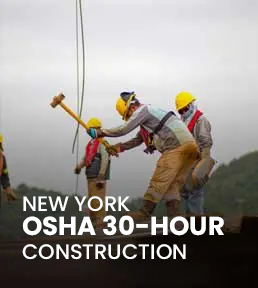Crane Safety and Basic Rigging Training Suite
Why Workers Choose Us
| features |  |
other providers |
|---|---|---|
| Instant Downloadable Certificate | ||
Free Study Guide

|
||
Discounts For Businesses

|
||
| No Hidden Cost | ||
Mobile Compatibility

|
||
Flexible Learning

|
Satisfied Customers
Course Outline
Basic Rigging Principles Part 1 (US)
-
1. Introduction
- Welcome
- Introduction
- Learning Objectives
-
2. Rigging Equipment Basics
- Chain
- Wire Rope
- Fiber Rope
- Inspection and Service
- Types of Rigging Equipment
-
3. Lifting Devices
- Lifting Devices
- Lifting Devices: Chain Hoists
- Lifting Devices: Come Alongs
- Lifting Devices: Jacks and Rollers
- Inspecting Chain Hoists
-
4. Slings
- Slings
-
5. Chain Slings
- Using Chain Slings
- Inspecting Chain Slings
- Chain Sling Inspections: Wear
- Chain Sling Inspections: Stretch
-
6. Wire Rope Slings
- Inspecting Wire Rope Slings
- Caring for and Storing Wire Rope Slings
-
7. Fiber Slings
- Synthetic Fiber Slings
- Inspecting Synthetic Fiber Slings
- Synthetic Fiber Sling Care and Storage
-
8. Types of Slings
- Types of Slings
- Endless Sling Hitches
- Single-Leg Sling Hitches
-
9. Hitches and Slings
- Vertical Hitches
- Choker Hitches
- Double-Wrap Choker Hitches
- Basket Hitches
- Multiple-Leg Hitches
-
10. Sling Tension
- Sling Tension
- Number of Legs
- Types of Hitch Bends in the Sling
- Sling Tension
- Sling Angle
-
11. Sling Storage and Capacity
- Sling Storage
- Sling Capacity Ratings
-
12. Connectors and Adjusters
- Connectors and Adjusters
- Using Hooks
-
13. Hook Inspections
- Inspecting Hooks
- Spreading
- Cracking
- Safety Latches
-
14. Shackles
- Using Shackles
- Inspecting Shackles
-
15. Eye Bolts
- Using Eye Bolts
- Inspecting Eye Bolts
-
16. Adjusters
- Adjusters
- Large Adjustments
- Using Turnbuckles
- Inspecting Turnbuckles
-
17. Care and Storage
- General Care and Storage
- Dropped Equipment
-
18. Summary
- Summary
Basic Rigging Principles Part 2
-
1. Introduction
- Welcome
- Introduction
- Learning Objectives
-
2. Safety
- Basic Rigging Safety Rules
- Rigging Safety Rules
- Personal Protective Equipment (PPE)
-
3. Job Planning
- Pre-Job Briefs
- Planning a Rigging Job
-
4. Load Weight
- Determine the Load Weight
-
5. Balance Point and Clearance
- Determine the Balance Point
- Check Clearances
-
6. Preparation
- Preparing for the Job
- Equipment Inspection
- Crew Organization
-
7. Selecting Equipment
- Equipment Capacity
- Load Angle Factors (LAF)
- D/d Ratio
-
8. Attaching Rigging
- Pre-Rigging
- Attaching the Rigging
- Attaching Eye Bolts, Shackles and Slings
- Attaching Shackles and Slings
- Attaching Hooks
- Attaching Rigging to the Hook
- Taglines
-
9. Summary
- Summary
Overhead and Gantry Crane Safety
-
1. Introduction
- Welcome
- Introduction
- Learning Objectives
- Crane Types
-
2. Testing and Inspections
- Testing
- Daily Inspections
- Documentation and Inspection
-
3. Crane Operating Procedures
- Preparing the Load
- Balancing the Load
- Moving the Load
- Moving the Load: Stopping and Speed
- Moving the Load: Protecting Personnel
- Moving the Load: Suspended Loads
- Parking a Crane or Hoist
-
4. Crane Components and Working Conditions
- Safe and Unsafe Conditions
- Ropes
- Sheaves and Guards
- Cabs
- Bumpers
- Trolley Stops
- Brakes
- Footwalks
- Ladders and Stairways
- Clearance
- Personnel
- Other Requirements
-
5. Electrical Equipment and Controllers
- Electrical Equipment
- Electrical Equipment Controllers
- Limit Switches
-
6. Summary
- Summary
Crane Operator Safety
-
1. Introduction
- Welcome
- Overview
- Learning Objectives
- Working Safely with Cranes
-
2. Worksite Preparation
- Worksite Preparation
- Support Surfaces: Floats
- Support Surfaces: Invisible Hazards
- Support Surfaces: Excavated Areas
- Transmitters
- Work Area
-
3. Power Lines
- Power Lines
- Maintain Safe Distances from Overhead Power Lines
- Cranes and Other High-Reaching Equipment
- Emergency Procedures for Power Line Contact
-
4. Crane Operation
- Operation Essentials
- Boom and Load Block
- Signaling
-
5. Special Operations
- Pick and Carry
- More Special Operations
-
6. Conditions Affecting Operations
- Conditions Affecting Operation
- The Environment
- Side Loading and Dynamic Loading
- Condition of Equipment
-
7. Conclusion
- Summary
Crane Hand Signaling Part 1 (US)
-
1. Introduction
- Welcome
- Learning Objectives
-
2. Capabilities, Limitations, & Dangers
- Definitions
- Introduction
- Crane Limitations
- Crane Operations
- Dynamic Loading
- Boom Deflection
- Boom Contact
- Stuck and Suspended Loads
- Machine Capabilities and Accidents
- Dangers for Crane Operations
-
3. Summary
- Summary
Crane Hand Signaling Part 2 (US)
-
1. Introduction
- Welcome
- Learning Objectives
- Introduction
-
2. Hand Signals
- Hand Signals
- Moving the Load
- Telescopic Booms
- Swinging, Moving Slowly and Traveling
- Stopping, Booming and People
- Trolley, Stopping and Dogging
-
3. Voice Signals
- Tower Cranes and Mobile Cranes
- Three Essential Elements
- Special Signals and Multiple Simultaneous Crane Functions
-
4. Summary
- Summary
Group Discount for Corporate Accounts

VIDEO TESTIMONIAL
FAQ
What is crane safety?
How long is the crane training course?
What are the topics for crane safety training?
What are the 5 basic rules of rigging?
What does it mean by rigging?
What is rigging in HSE?
What is the responsibility of a rigger?
Join our mailing list
Get announcements, industry updates and promotional offers.









